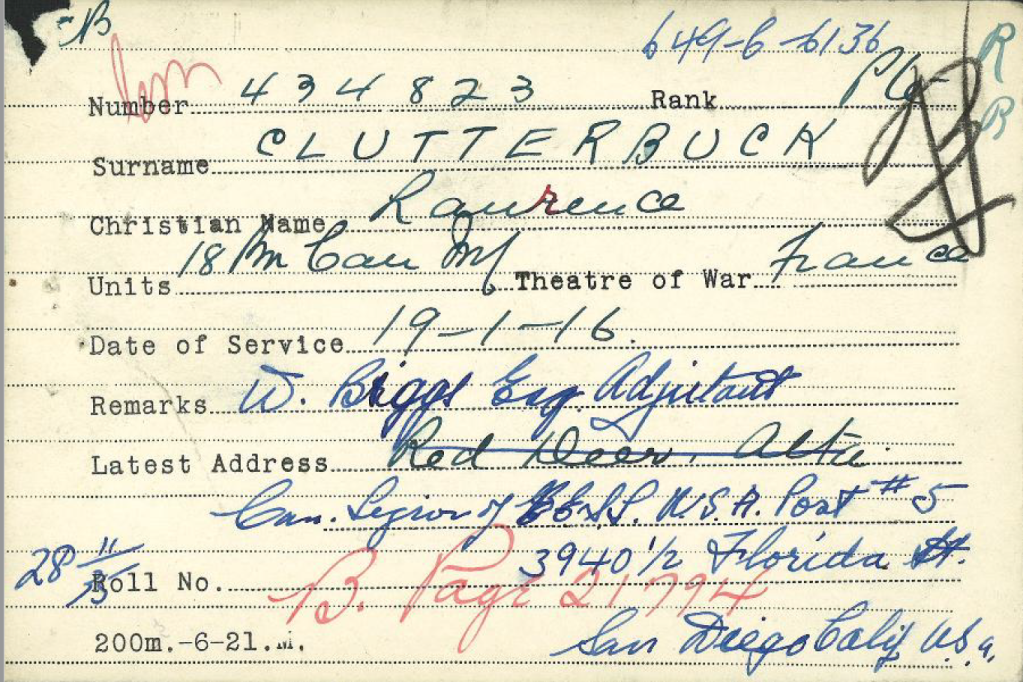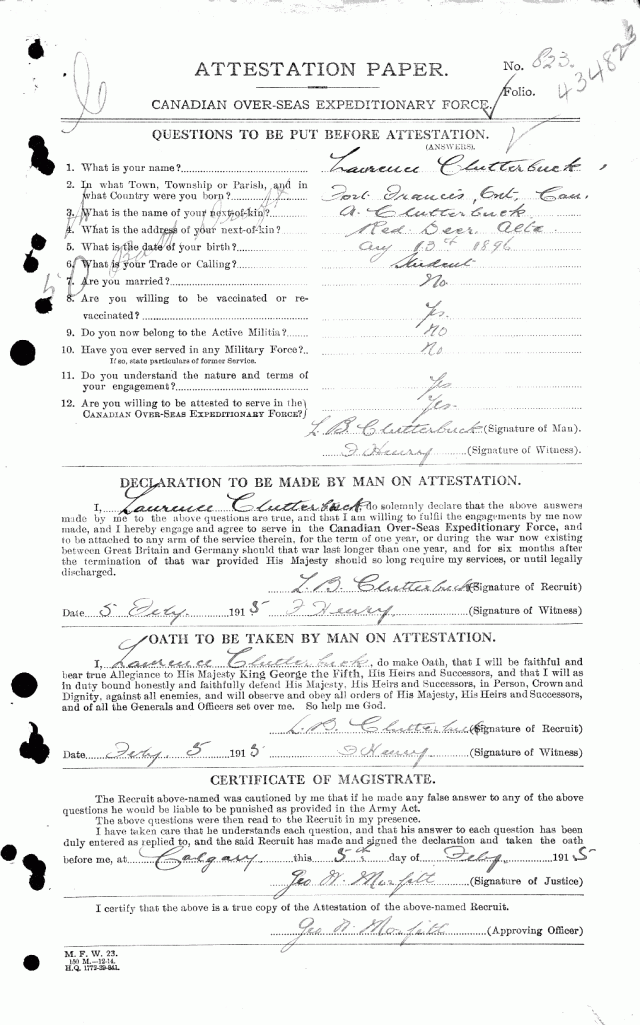Source: Kenora Great War Project search for 18th Battalion soldiers.
Private Lawrence Clutterbuck enlisted in Calgary in February 1915, at age 17, and served in France and Belgium with the 18th Battalion and the Canadian Machine Gun Corps. He suffered shell shock and shell gas poisoning but he recovered and returned home in June 1919.
Lawrence was the son of Austin Clutterbuck and Ruth Land of Red Deer, Alberta. Austin (aka Augustin) was born in 1872 in Bredon, Worcestershire, England. Austin’s father, Lorenzo Clutterbuck, was from Ireland and his mother, Lucy Deborah Mary Woodward, was born in Cambridge, England. Austin’s wife Ruth Land was born in 1874 in Kingston upon Thames, Surrey, England, the daughter of William and Martha Land. Austin and Ruth both immigrated to Canada, Ruth arriving in the late 1880s with her family and settling in Winnipeg. She had at least four sisters and a brother Arthur.
Austin and Ruth were married in Winnipeg on 1 June 1896 and they made their home in the town of Rat Portage (later renamed Kenora), in northwestern Ontario. Lawrence was born there on 13 July 1897, followed by his brother Arthur Bernard in July 1899. When the 1901 census was taken the family was still living in Rat Portage and Austin was a dairyman. By 1906 they were in Winnipeg and from there they moved to Red Deer, Alberta. Austin worked in a lumber mill then became a farmer and homesteader. Tragically Bernard died in February 1913, at age 13, when Lawrence accidentally shot him with a revolver. He’s buried in Red Deer Cemetery.
The war started in August 1914 and Lawrence enlisted in Calgary six months later, on 5 February 1915. He was only 17 at the time but he passed himself off as a year older. His service file records his place of birth incorrectly as Fort Frances, Ontario. He was still a student when he enlisted and next of kin was his father in Red Deer. Lawrence joined the 50th (Calgary) Battalion and trained with them through the spring and summer. During that time the 1st Canadian Division was fighting in France and Belgium. Men were needed to replace casualties in front line units and battalions in Canada were asked to send reinforcements. Lawrence embarked for the UK on 11 September 1915 as part of the 2nd reinforcing draft.
Not long after arriving in England Lawrence attended a Colt machine gun course. On 19 January 1916 he was transferred to the 18th Battalion and sent to France. He joined his unit in the field in early February. The Canadians were in the Ypres Salient at the time, holding a section of the front line between St. Eloi and Hooge. In June they took part in the Battle of Mount Sorrel and late that summer they moved to the Somme for the major offensive that had started on 1 July. Lawrence suffered shell shock at the end of September and he recovered for a few days at a field ambulance. On 23 October he was transferred to the 4th Canadian Machine Gun Company. In November he was ill with a fever and out of action for about a week, and in December he was posted to the Canadian Machine Gun Reinforcing Pool.
In March 1917 Lawrence was sent to the Canadian Base Depot. A month later he was classified as permanent base and assigned to the Canadian Corps Composite Company. He had ten days leave in England in May and in August 1917 he was transferred to the 1st Canadian Divisional Employment Company. Employment company personnel had a wide variety of duties including traffic control, salvaging, sanitation, road building, burials, policing and working at headquarters. Lawrence was ill with influenza in July 1918 but out of action for only a few days. In early August he was transferred to the 2nd Battalion, Canadian Machine Gum Corps. The final period of the war started on 8 August with the Battle of Amiens and Lawrence joined his unit during the battle. In late September the Canadians crossed the Canal du Nord and began advancing on Cambrai. Lawrence suffered shell gas poisoning around 7 October and he was evacuated to No. 2 Canadian Stationary Hospital in Outreau.
After recovering for three weeks Lawrence was moved to a convalescent depot at Aubengue. He was discharged to duty on 11 November, the day the Armistice was signed. After some time at a divisional rest camp he was assigned to the 4th Battalion, Canadian Machine Gun Corps on 25 December. He served in Belgium and France for another four months. He returned to England on 1 May 1919 and sailed for Canada on the SS Olympic on 6 June, arriving in Halifax a week later. He was discharged on demobilization on 20 June in Toronto.
Lawrence’s intended residence after his service was Red Deer but by 1921 he was living in Windsor, Ontario with his mother. His parents’ marriage appears to have ended and his father stayed in Red Deer, later moving to British Columbia and apparently remarrying. In 1922 Lawrence and his mother moved to San Diego, California. They lived together and he worked as an auto mechanic and trainman before joining the San Diego police force on 10 January 1929, at age 31. In May 1933 he was one of nine officers injured during a communist parade and riot in San Diego. Around that same time he married and city directories listed his wife as Billie E. Clutterbuck. By 1939 they were likely separated as they were listed at different addresses.
Lawrence passed away at home on 23 December 1939, at age 42. His funeral was held three days later and he’s buried at Glen Abbey Memorial Park in Bonita, San Diego County. His father died in Maple Ridge, British Columbia in 1956 and he’s buried in Maple Ridge Cemetery. Lawrence’s mother Ruth passed away in San Diego in 1970, at age 96.
By Becky Johnson







